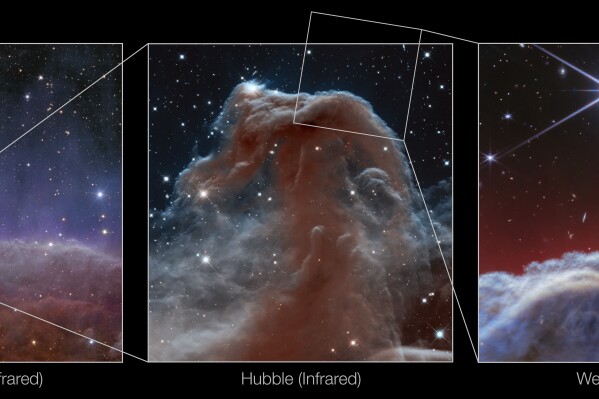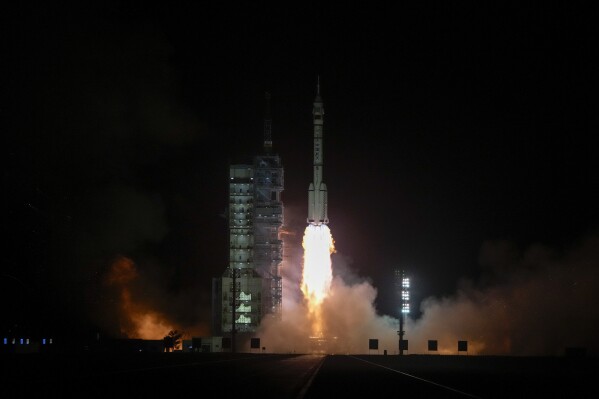SPACE
Webb telescope takes stunning images of Horsehead Nebula's 'mane'
Agence France-Presse
April 30, 2024

The new observations show the top of the "horse's mane," revealing for the first time the small scale structures on the edge of the giant cloud of dust and gas (NASA)
NASA's James Webb telescope has captured the most detailed infrared images ever taken of the Horsehead Nebula, one of the most majestic and recognizable objects in the night sky, the space agency said Monday.
The new observations show the top of the "horse's mane," revealing for the first time the small scale structures on the edge of the giant cloud of dust and gas.
Located roughly 1,300 light years away in the constellation Orion ("The Hunter"), the iconic silhouette of a horse's head and neck rises from what look like churning waves of interstellar foam.
Webb, the most powerful space observatory ever built, is able to detect infrared light at unprecedented resolutions, revealing objects that cannot be seen using the visible spectrum in optical telescopes.
"An international team of astronomers has revealed for the first time the small-scale structures of the illuminated edge of the Horsehead," a NASA statement said.
As ultraviolet light evaporates the dust cloud, particles are swept away by the outflow of heated gas -- a process Webb has now shown in action.
The observations have also given astronomers new insights into how dust blocks and emits light, and a better idea of the nebula's multidimensional shape.
The work was the result of an study led by Karl Misselt of the University of Arizona, and published Monday in Astronomy & Astrophysics.
The Horsehead Nebula has fascinated space enthusiasts since its discovery in 1888 by the renowned Scottish astronomer Williamina Fleming.
While it appears shadowy in optical light, the nebula comes to life when viewed through infrared wavelengths, taking on transparent and ethereal hues.
This delicate pillar of hydrogen gas infused with dust is being steadily worn away by the radiation of a nearby star. Astronomers estimate the Horsehead will disappear in another five million years.
Agence France-Presse
April 30, 2024

The new observations show the top of the "horse's mane," revealing for the first time the small scale structures on the edge of the giant cloud of dust and gas (NASA)
NASA's James Webb telescope has captured the most detailed infrared images ever taken of the Horsehead Nebula, one of the most majestic and recognizable objects in the night sky, the space agency said Monday.
The new observations show the top of the "horse's mane," revealing for the first time the small scale structures on the edge of the giant cloud of dust and gas.
Located roughly 1,300 light years away in the constellation Orion ("The Hunter"), the iconic silhouette of a horse's head and neck rises from what look like churning waves of interstellar foam.
Webb, the most powerful space observatory ever built, is able to detect infrared light at unprecedented resolutions, revealing objects that cannot be seen using the visible spectrum in optical telescopes.
"An international team of astronomers has revealed for the first time the small-scale structures of the illuminated edge of the Horsehead," a NASA statement said.
As ultraviolet light evaporates the dust cloud, particles are swept away by the outflow of heated gas -- a process Webb has now shown in action.
The observations have also given astronomers new insights into how dust blocks and emits light, and a better idea of the nebula's multidimensional shape.
The work was the result of an study led by Karl Misselt of the University of Arizona, and published Monday in Astronomy & Astrophysics.
The Horsehead Nebula has fascinated space enthusiasts since its discovery in 1888 by the renowned Scottish astronomer Williamina Fleming.
While it appears shadowy in optical light, the nebula comes to life when viewed through infrared wavelengths, taking on transparent and ethereal hues.
This delicate pillar of hydrogen gas infused with dust is being steadily worn away by the radiation of a nearby star. Astronomers estimate the Horsehead will disappear in another five million years.
European satellite giant SES to buy US rival Intelsat
By AFP
April 30, 2024

SES and Intelsat are facing growing competition from firms providing services from low Earth orbits, like Elon Musk's Starlink - Copyright AFP/File PASCAL GUYOT
Kilian FICHOU
European satellite group SES will acquire US rival Intelsat for $3.1 billion, the companies said Tuesday, seeking to compete in a race for space-based internet service led by Elon Musk’s Starlink.
The merger, which follows year-long talks, comes as Musk already has a constellation of internet satellites while Amazon has launched its own tests.
“In a fast-moving and competitive satellite communication industry, this transaction expands our multi-orbit space network,” SES chief executive Adel Al-Saleh said in a statement.
SES and Intelsat said in a joint statement that 60 percent of the combined group’s revenue would come from “high growth segments” and generate an annual core profit of 1.8 billion euros ($1.9 billion).
“The combination will create a stronger multi-orbit operator with greater coverage,” the statement said.
The boards of both companies unanimously approved the transaction, which they expect to close in the second half of 2025 pending approval from regulators.
The move comes four years after Intelsat filed for Chapter 11 bankruptcy protection in the United States and launched a broad restructuring programme to tame its debt.
Founded in 1964 as an intergovernmental consortium to own and manage a constellation of communications satellites, then privatised in the early 2000s, Intelsat now has more than 50 geostationary satellites.
SES for its part last year generated sales closing in on two billion euros ($2.15 billion), a nine percent increase.
But it ended the year in the red with net losses of 34 million euros as video transmission receipts slid amid competition from fiber-optic video streaming services.
The groups distributes transmission capacity to more than 8,000 TV broadcasters across the globe.
The sector faces growing competition for space-based internet service, which satellite operator Eutelsat says could be worth $16 billion by 2030.
Musk’s Starlink has taken the lead with a system promising broadband service even in the most remote locations.
Starlink says it has placed 5,000 satellites in low Earth orbit and has 2.3 million customers. It aims to deploy nearly 30,000 satellites.
Amazon, the company founded by Jeff Bezos, launched two test satellites last year as part of its Project Kuiper to deliver internet service from space. It aims to have more than 3,200 satellites in low orbit.
China plans to launch 13,000 satellites as part of its GuoWang constellation, while Canada’s Telesat will add 300 and German start-up Rivada is eyeing 600.
That will be in addition to the European Union’s Iris project — 170 satellites — and the 300-500 satellites planned to be launched by the US military’s Space Development Agency.
Eutelsat has merged with Britain’s OneWeb in efforts to compete in the market.
By AFP
April 30, 2024

SES and Intelsat are facing growing competition from firms providing services from low Earth orbits, like Elon Musk's Starlink - Copyright AFP/File PASCAL GUYOT
Kilian FICHOU
European satellite group SES will acquire US rival Intelsat for $3.1 billion, the companies said Tuesday, seeking to compete in a race for space-based internet service led by Elon Musk’s Starlink.
The merger, which follows year-long talks, comes as Musk already has a constellation of internet satellites while Amazon has launched its own tests.
“In a fast-moving and competitive satellite communication industry, this transaction expands our multi-orbit space network,” SES chief executive Adel Al-Saleh said in a statement.
SES and Intelsat said in a joint statement that 60 percent of the combined group’s revenue would come from “high growth segments” and generate an annual core profit of 1.8 billion euros ($1.9 billion).
“The combination will create a stronger multi-orbit operator with greater coverage,” the statement said.
The boards of both companies unanimously approved the transaction, which they expect to close in the second half of 2025 pending approval from regulators.
The move comes four years after Intelsat filed for Chapter 11 bankruptcy protection in the United States and launched a broad restructuring programme to tame its debt.
Founded in 1964 as an intergovernmental consortium to own and manage a constellation of communications satellites, then privatised in the early 2000s, Intelsat now has more than 50 geostationary satellites.
SES for its part last year generated sales closing in on two billion euros ($2.15 billion), a nine percent increase.
But it ended the year in the red with net losses of 34 million euros as video transmission receipts slid amid competition from fiber-optic video streaming services.
The groups distributes transmission capacity to more than 8,000 TV broadcasters across the globe.
The sector faces growing competition for space-based internet service, which satellite operator Eutelsat says could be worth $16 billion by 2030.
Musk’s Starlink has taken the lead with a system promising broadband service even in the most remote locations.
Starlink says it has placed 5,000 satellites in low Earth orbit and has 2.3 million customers. It aims to deploy nearly 30,000 satellites.
Amazon, the company founded by Jeff Bezos, launched two test satellites last year as part of its Project Kuiper to deliver internet service from space. It aims to have more than 3,200 satellites in low orbit.
China plans to launch 13,000 satellites as part of its GuoWang constellation, while Canada’s Telesat will add 300 and German start-up Rivada is eyeing 600.
That will be in addition to the European Union’s Iris project — 170 satellites — and the 300-500 satellites planned to be launched by the US military’s Space Development Agency.
Eutelsat has merged with Britain’s OneWeb in efforts to compete in the market.
In this photo released by Xinhua News Agency, the capsule of Shenzhou-17 manned spaceship carrying astronauts Tang Hongbo, Tang Shengjie and Jiang Xinlin touches down at the Dongfeng landing site in north China’s Inner Mongolia Autonomous Region, Tuesday, April 30, 2024. The return capsule of China’s Shenzhou-17 manned spaceship landed back on Earth Tuesday with three astronauts who have completed a six-month mission aboard the country’s orbiting space station. (Bei He/Xinhua via AP)
April 30, 2024
BEIJING (AP) — China’s Shenzhou-17 spacecraft returned to Earth Tuesday, carrying three astronauts who have completed a six-month mission aboard the country’s orbiting space station.
The three, Tang Hongbo, Tang Shengjie and Jiang Xinlin, landed at the Dongfeng site in north China’s Inner Mongolia Autonomous Region in the Gobi desert shortly before 6:00 p.m. (1000 GMT). It comes roughly four days after the Shenzhou-18 mission docked with the station with their three-member replacement crew onboard.
China built its own space station after being excluded from the International Space Station, largely because of U.S. concerns over the Chinese military’s total control of the space program amid a sharpening competition in technology between the two geopolitical rivals. This year, the Chinese station is slated for two cargo spacecraft missions and two manned spaceflight missions.
China’s ambitious space program aims to put astronauts on the moon by 2030, as well as bring back samples from Mars around the same year and launch three lunar probe missions over the next four years.
The new crew is made up of Commander Ye Guangfu, 43, a veteran astronaut who took part in the Shenzhou-13 mission in 2021, and fighter pilots Li Cong, 34, and Li Guangsu, 36, who are spaceflight rookies.
READ MORE

A horse-shaped nebula gets its close-up in new photos by NASA’s Webb telescope

NASA astronauts arrive for Boeing’s first human spaceflight

China launches 3-member crew to its space station as it seeks to put astronauts on the moon by 2030
They will spend about six months on the three modules of the space station, the Tiangong, which can accommodate up to six astronauts at a time. During their stay, they will conduct scientific tests, install space debris protection equipment, carry out payload experiments, and beam science classes to students on Earth.
China has also said that it eventually plans to offer access to its space station to foreign astronauts and space tourists. With the ISS nearing the end of its useful life, China could in future remain the only country or corporation to maintain a crewed station in orbit.
China conducted its first crewed space mission in 2003, becoming the third country after the former Soviet Union and the U.S. to put a person into space using its own resources. Tiangong was launched in 2021 and completed 18 months later.
The U.S. space program is believed to still hold a significant edge over China’s due to its spending, supply chains and capabilities. However, China has broken out in some areas, bringing samples back from the lunar surface for the first time in decades and landing a rover on the less explored far side of the moon.
The U.S. aims to put a crew back on the lunar surface by the end of 2025 as part of a renewed commitment to crewed missions, aided by private sector players such as SpaceX and Blue Origin.
BEIJING (AP) — China’s Shenzhou-17 spacecraft returned to Earth Tuesday, carrying three astronauts who have completed a six-month mission aboard the country’s orbiting space station.
The three, Tang Hongbo, Tang Shengjie and Jiang Xinlin, landed at the Dongfeng site in north China’s Inner Mongolia Autonomous Region in the Gobi desert shortly before 6:00 p.m. (1000 GMT). It comes roughly four days after the Shenzhou-18 mission docked with the station with their three-member replacement crew onboard.
China built its own space station after being excluded from the International Space Station, largely because of U.S. concerns over the Chinese military’s total control of the space program amid a sharpening competition in technology between the two geopolitical rivals. This year, the Chinese station is slated for two cargo spacecraft missions and two manned spaceflight missions.
China’s ambitious space program aims to put astronauts on the moon by 2030, as well as bring back samples from Mars around the same year and launch three lunar probe missions over the next four years.
The new crew is made up of Commander Ye Guangfu, 43, a veteran astronaut who took part in the Shenzhou-13 mission in 2021, and fighter pilots Li Cong, 34, and Li Guangsu, 36, who are spaceflight rookies.
READ MORE
A horse-shaped nebula gets its close-up in new photos by NASA’s Webb telescope
NASA astronauts arrive for Boeing’s first human spaceflight
China launches 3-member crew to its space station as it seeks to put astronauts on the moon by 2030
They will spend about six months on the three modules of the space station, the Tiangong, which can accommodate up to six astronauts at a time. During their stay, they will conduct scientific tests, install space debris protection equipment, carry out payload experiments, and beam science classes to students on Earth.
China has also said that it eventually plans to offer access to its space station to foreign astronauts and space tourists. With the ISS nearing the end of its useful life, China could in future remain the only country or corporation to maintain a crewed station in orbit.
China conducted its first crewed space mission in 2003, becoming the third country after the former Soviet Union and the U.S. to put a person into space using its own resources. Tiangong was launched in 2021 and completed 18 months later.
The U.S. space program is believed to still hold a significant edge over China’s due to its spending, supply chains and capabilities. However, China has broken out in some areas, bringing samples back from the lunar surface for the first time in decades and landing a rover on the less explored far side of the moon.
The U.S. aims to put a crew back on the lunar surface by the end of 2025 as part of a renewed commitment to crewed missions, aided by private sector players such as SpaceX and Blue Origin.
No comments:
Post a Comment